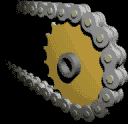
Back ناقل حركة بالسلاسل Arabic Zəncir ötürməsi Azerbaijani Ланцуговая перадача Byelorussian Cadena de transmissió Catalan Kettengetriebe German Transmisia ĉeno Esperanto Cadena de transmisión Spanish Kettülekanne Estonian Transmisio-kate Basque Ketjuvälitys Finnish

Chain drive is a way of transmitting mechanical power from one place to another. It is often used to convey power to the wheels of a vehicle, particularly bicycles and motorcycles. It is also used in a wide variety of machines besides vehicles.
Most often, the power is conveyed by a roller chain, known as the drive chain or transmission chain,[1] passing over a sprocket, with the teeth of the gear meshing with the holes in the links of the chain. The gear is turned, and this pulls the chain putting mechanical force into the system. Another type of drive chain is the Morse chain, invented by the Morse Chain Company of Ithaca, New York, United States. This has inverted teeth.[2]
Sometimes the power is output by simply rotating the chain, which can be used to lift or drag objects. In other situations, a second gear is placed and the power is recovered by attaching shafts or hubs to this gear. Though drive chains are often simple oval loops, they can also go around corners by placing more than two gears along the chain; gears that do not put power into the system or transmit it out are generally known as idler-wheels. By varying the diameter of the input and output gears with respect to each other, the gear ratio can be altered. For example, when the bicycle pedals' gear rotates once, it causes the gear that drives the wheels to rotate more than one revolution. Duplex chains are another type of chain which are essentially two chains joined side by side which allow for more power and torque to be transmitted.
- ^ Machinery's Handbook (1996), pp. 2337–2361.
- ^ First Directory Ltd. "First Directory Ltd – 1st for business information". 1stdirectory.com. Archived from the original on 2007-11-27. Retrieved 2008-02-01.
{{cite web}}:|author=has generic name (help)